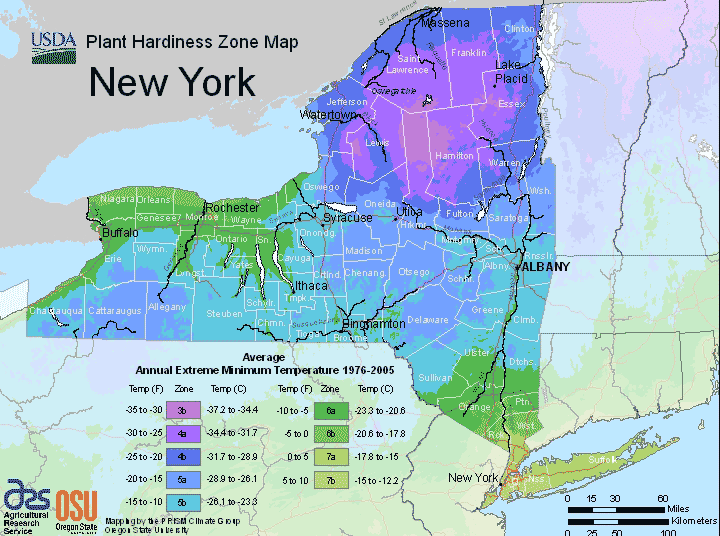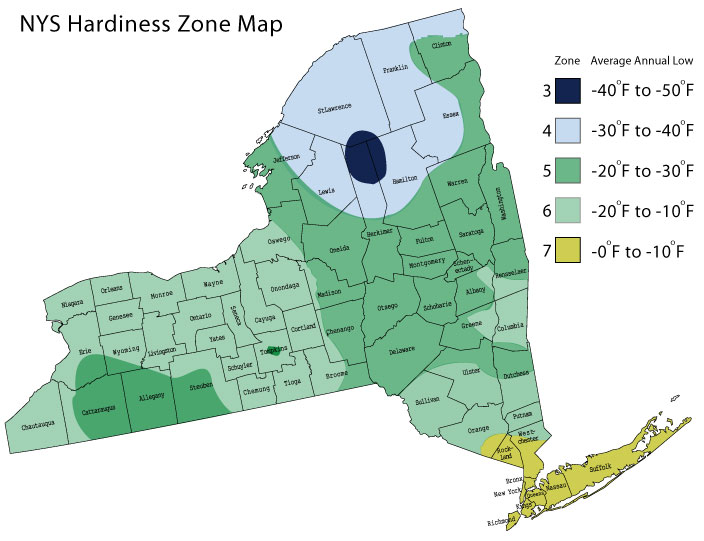
Table of Contents
Characteristics of New York Planting Region
New York State is subject to a range of extreme weather conditions, including:
The duration of the growing season differs from region to region. Last frost may occur between April 15th and May 15th, while the first frost usually takes place between September 1st and October 15th.
Challenges of Growing in New York
1. Extreme Weather
Extreme weather conditions in the state can be hazardous for gardeners. Utilizing raised garden beds and coverings is wise to protect plants from droughts, storms, and floods.
2. Heat Waves
3. Heavy Snowfall
New York State is known for its heavy annual snowfall, usually around 70 inches. This can make it hard to cultivate plants in the winter unless you use a protective covering or indoor growing.
An Abundance of Beauty: Best Plants for New York’s Planting Zone

New York’s varied landscapes, from bustling urban environments to scenic countryside, offer an exciting opportunity for gardening enthusiasts to cultivate a diverse range of plants. The state’s planting zones span from Zone 3 in the northern regions to Zone 7 in the southern areas, accommodating a wide range of climates and growing conditions. By selecting the right plants that flourish in New York’s unique environment, gardeners can create an abundance of beauty in their landscapes. Here are some of the best plants to grow in New York’s planting zone:
- New York Roses (Rosa spp.): Roses are a classic favorite in New York gardens, known for their stunning blooms and delightful fragrance. Hybrid tea roses, floribundas, and climbing roses are among the popular choices to add charm to the landscape.
- Hostas (Hosta spp.): Hostas are a popular choice for New York gardens, especially in shaded areas. With a variety of sizes and leaf colors available, they bring texture and elegance to the landscape.
- New York Apples (Malus spp.): New York is famous for its apple production, making apple trees an excellent option for home fruit growers. Varieties like McIntosh, Empire, and Honeycrisp are among the favorites for their delicious fruits.
- Coneflowers (Echinacea spp.): Coneflowers are tough and adaptable perennials that thrive in New York’s planting zone. Their daisy-like flowers in shades of pink, white, and purple attract butterflies and pollinators.
- New York Maples (Acer spp.): New York is abundant with maple trees, and Sugar Maples are particularly renowned for their stunning fall foliage. These majestic trees add beauty and character to the landscape.
- Daylilies (Hemerocallis spp.): Daylilies are low-maintenance perennials that bring an array of colors to New York gardens. These hardy plants bloom throughout the summer, adding a cheerful touch to any landscape.
- New York Dogwoods (Cornus spp.): New York is home to several dogwood species, including the flowering dogwood and kousa dogwood. These ornamental trees offer showy blooms and attractive berries, adding visual interest to the garden.
- New York Peonies (Paeonia spp.): Peonies are a beloved favorite in New York gardens, known for their luxurious blooms and enchanting fragrance. These long-lived perennials thrive in the state’s temperate climate and add elegance to any landscape.
- Astilbes (Astilbe spp.): Astilbes are shade-loving perennials that add a soft and delicate touch to New York gardens. Their feathery plumes of flowers come in various colors and bring a graceful presence to shaded areas.
- New York Lilacs (Syringa spp.): Lilacs are a cherished favorite in New York gardens, renowned for their stunning spring blooms and enchanting fragrance. These deciduous shrubs add a touch of nostalgia and beauty to the landscape.
To ensure successful gardening in New York, it’s essential to consider the state’s changing seasons and varying microclimates. New York experiences cold winters, so selecting cold-hardy plants that can withstand freezing temperatures is crucial.
Proper soil preparation, including adding organic matter and maintaining good drainage, is essential for healthy plant growth. Mulching helps retain soil moisture and regulate temperature, particularly during temperature fluctuations.
Watering practices should be adjusted according to the weather conditions, ensuring plants receive adequate hydration during dry spells and drier periods of the year. Rainwater harvesting can be employed to conserve water and reduce water usage.
Urban gardeners in New York may face challenges with limited space and higher temperatures in built-up areas. Vertical gardening, container gardening, and choosing heat-tolerant varieties can help overcome these challenges.
From the timeless beauty of roses and peonies to the delicious fruits of apples and the vibrant hues of maples and dogwoods, the best plants for New York gardens celebrate the state’s natural beauty and complement its varied environments. By embracing the changing seasons and selecting plants well-suited to New York’s climate, gardening enthusiasts can create an abundance of beauty that enhances the charm of the Empire State.
FAQ
What plant zone am i in ny?
New York falls within USDA hardiness zones 3-7, and has an average of 135 days between the last and first frost, though there is a 10% chance of frost before or after these dates. Monitor local weather for more precise information.
What zone is upstate NY?
Knowing the initial and final frost dates can aid you in beginning your veggie seeds at the appropriate time. New York falls into USDA plant hardiness zones 3-7.
What climate zone is New York?
Climate of humid subtropics with scorching summers and gentle winters, characterized by hot summers and mild winters
What plant zone is Long Island?
Most of Long Island is now Zone 7a, while the northern portion of western and central Nassau and the southern region from the Queens-Nassau border to Gilgo Beach are in 7b, which is warmer.
What planting zone is Suffolk County NY?
Suffolk County, New York falls within USDA Hardiness Zones 7a and 7b.
